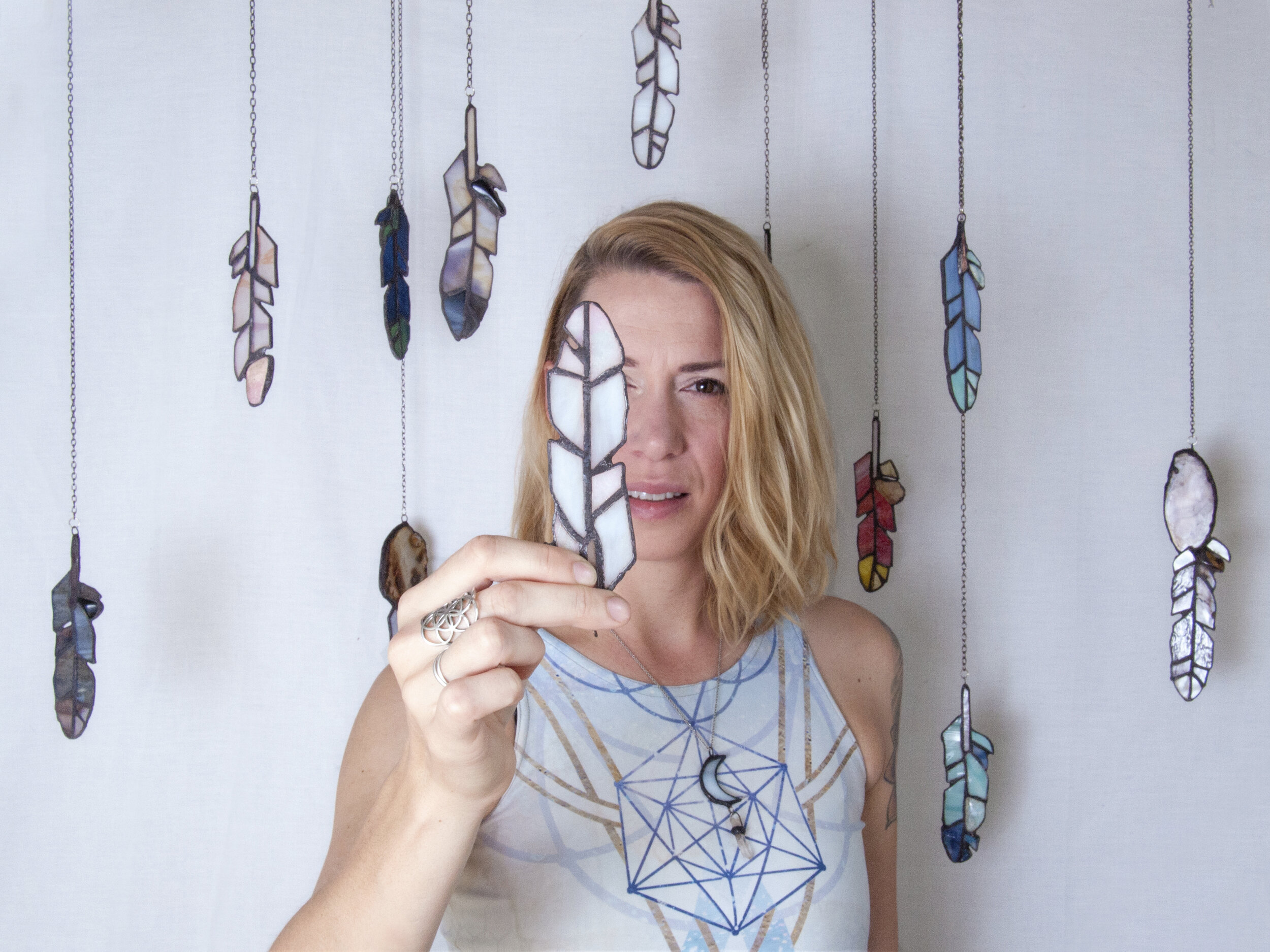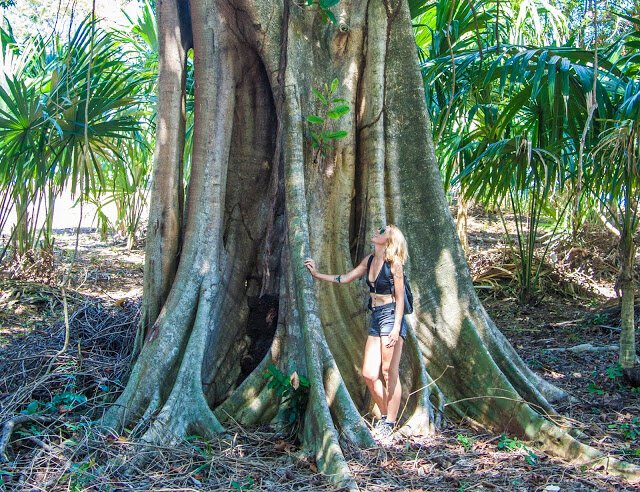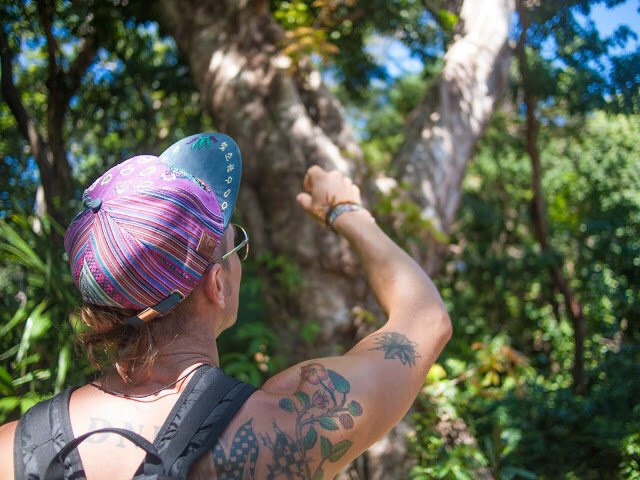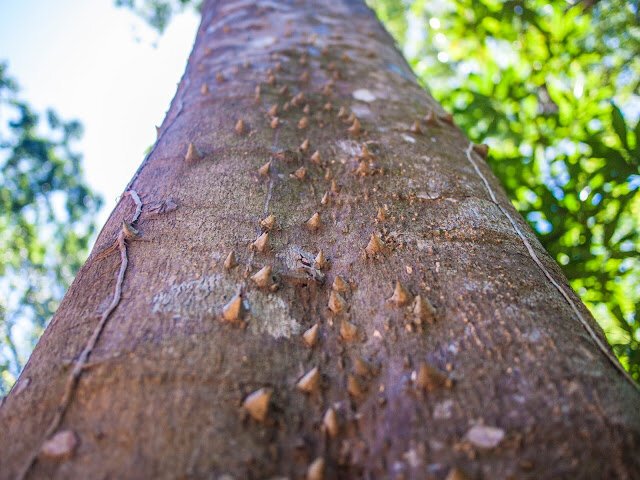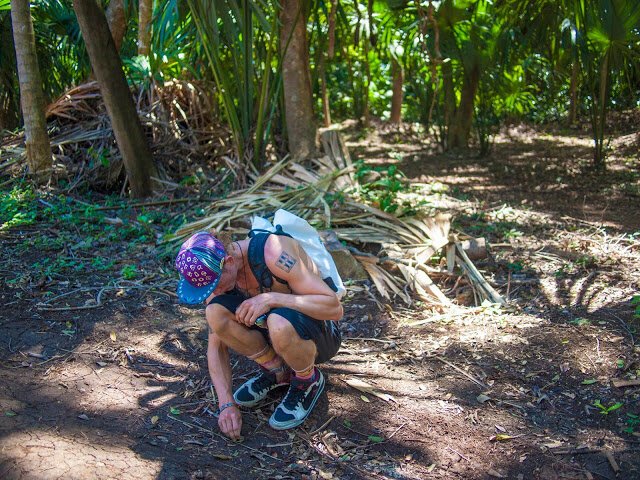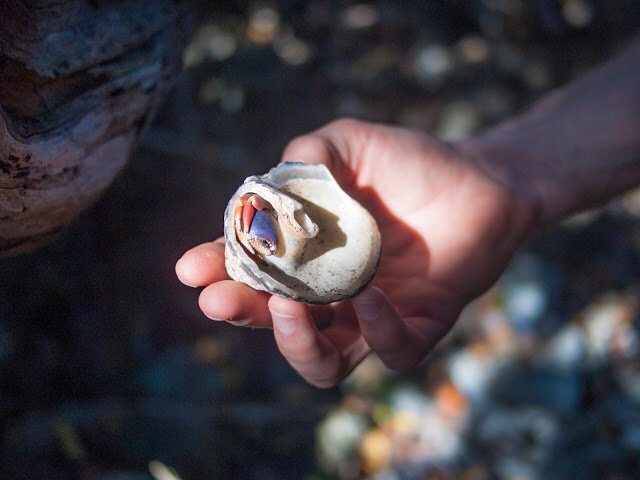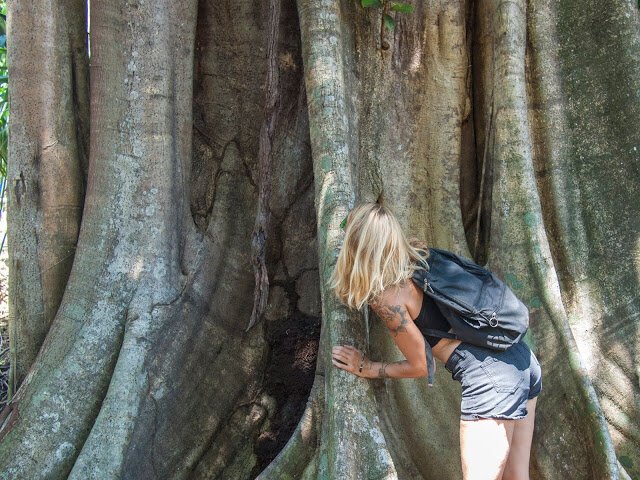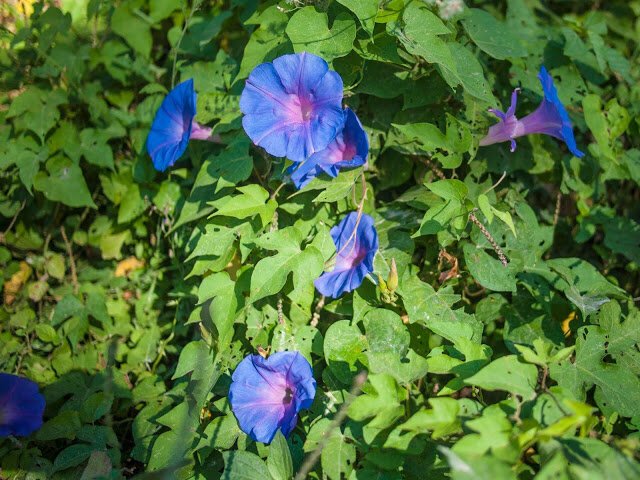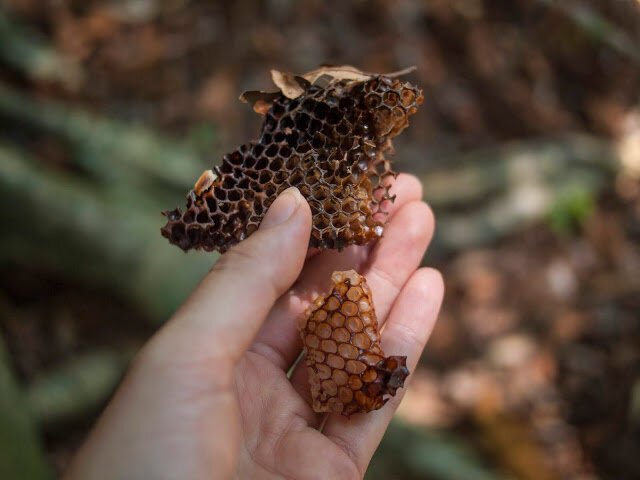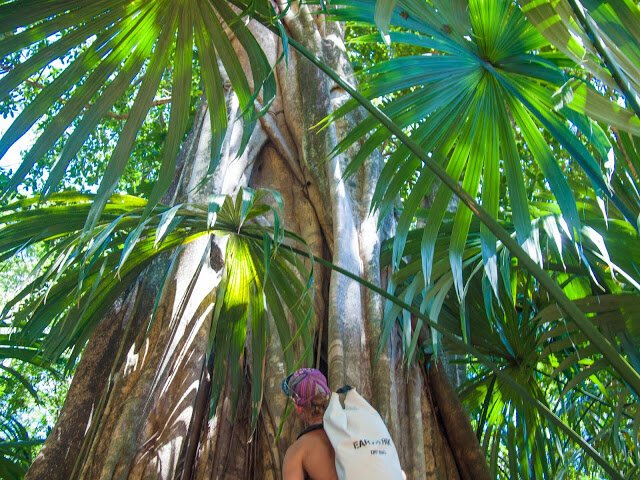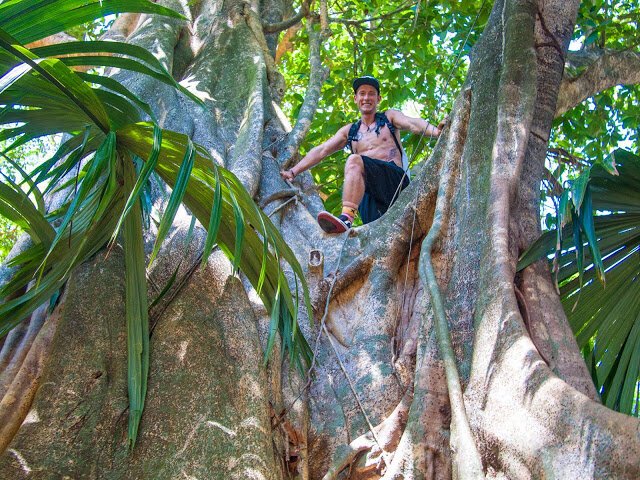And for those of you who prefer to read:
Transcription:
Hello everyone! Thank you so much for being here! I want to thank Kat for setting up this wonderful weekend where we can have access to incredible information for free. I met Kat when she interviewed me last spring and I am so honored to be invited back to be a part of her first Wellness Weekend. It is such an inspiring initiative.
I’m also really excited to be able to talk about something that’s a huge passion of mine, which is helping people engage in spiritual practice. I wanted to match Kat’s initiative and give as much value as I could in this talk, so it is pretty dense.
But I figured that if you were showing up to this, it’s likely that you’re a thinking and intelligent person who’s at least dabbled in this type of stuff before. So I tried to strike a balance between simplifying this topic, but also giving you something to sink your teeth into.
So, in this talk, I’m going to speak about creating a spiritual practice and give you some steps for how to do that. I’m going to give you a little bit of history about myself and also about the cultural shift we’re experiencing as we’re moving from large-scale religions towards a personalized spiritual practice.
I’m going to give you some skills for how to use rituals from other religions to create a spiritual practice that’s right for you. I’m going to show you how to tap into your intuition, how to get creative, and have fun in designing a daily practice. And I’m also going to tackle the issue of cultural appropriation in new spirituality, and hopefully give you some skills for how to know if your practices are damaging others.
So, let’s get to it!
Why We Need To Be Engaged In Creating Our Own Spiritual Path
So in the last couple of years the term, “Spirituality,” has become separate from the idea of Religion. During most of the history of our planet, having a spiritual practice was synonymous with being religious. But we’re suddenly at a tipping point where, with each generation, people are moving away from organized religion.
According to a study by Pew Research Centre in 2012, one-fifth of the US public and a third of adults under the age of 30 are unaffiliated with any religion but identify as being spiritual in some way. What generation you’re in drastically affects your opinion. For those who desire a spiritual practice, those who are older prefer religion, while the younger Millennials drastically skew toward being unaffiliated.
What’s interesting to me is that people aren’t giving up on spirituality altogether. About 25 years ago I remember watching a few key voices pushing for atheism, but I quickly watched the disillusionment of nihilism turn people towards finding a greater purpose. That same study states that even among the 4% of people who register as American atheists, a full third say that, while they don’t believe in God, they do consider themselves spiritual, and in some cases, even religious. So why the shift?
Well, it used to be that religion was what gave us guidelines for morality, and functional rules of living, as well as a sense of connection to something greater. Our religious inclination was passed on to us by our parents and solidified by the community we lived in for our entire lives.
But with increased travel and access to information, we’re no longer surrounded by only one voice. If you’re listening to this talk, then you have access to the internet, and that means you have all of the written knowledge of the universe at your fingertips. On top of that, our community is no longer linked to where we grew up. Most adults now move several times in our lives, and because of the internet, we can find a community that better aligns with our values.
Also, because of broadened communities and new information, it’s difficult to pass over the problematic dogma that exists in most major religions. Many large religious spaces have issues with things like patriarchy, racism, and nationalism. Since we’re living in a time where we can connect with and understand people who aren’t exactly like us, people are starting to move away from ideas that are outdated and hurtful to others.
So why are people deciding to have any spiritual practice at all? Why not just move away from religion and be done with it?
Well, science tells us that people who are spiritual measurably have better lives. Spiritual people are proven to be more optimistic, have a sense of purpose, have higher self-esteem, and more nourishing relationships. All of these aspects inherently make individuals more successful and have a higher quality of life.
Because the fact is, even with the gifts our era gives us, we live in a more emotionally challenging environment than our ancestors. Our ancestors’ worlds used to be much smaller, which made stress much more manageable. When a problem occurred, it was generally in their physical space, which allowed them some capacity to try and solve it.
But as all of you know, that’s no longer the case. We now live with constant information about all the terrible things that are happening globally, with little capacity to do something to help. We no longer get to leave our work at work, because we’re always reachable and that makes us always available. Our multiple social media accounts leave us open to an exhaustive amount of human interaction while making our relationships less meaningful and fulfilling. We are being failed by all of the things that are supposed to give us a sense of hope, failed by our religion, our jobs, our family structure.
We have a near-constant bombardment of problem solving and negotiations, which leads us to need stimulants to keep up, while at the same time having to numb out our stress with food, tv, and intoxicants. Our spirits are begging for a break, for balance, for rest.
But one of the most amazing human qualities is that we evolve. We continue to let go of things that don’t work for us, and move towards things that do. And one of the things that is bringing back our sense of hope, purpose, and peace, is this new era of spirituality.
For the first time, each person gets to make up a practice that’s personal and truly fulfills our individual needs. In most cases, we’re no longer ostracized for not practicing our local religion but can find others of like mind to teach us and support us. Because of our vast access to information, we can make something that’s ours, and people are finding massive hope in that.
About Me
So before I get into some of these strategies, I think it’s important that you know a little bit about me and my background.
I work as a professional visual artist, as you can see by my probably overkill surroundings, and I didn’t always know that spirituality was my passion, in fact, most of my life I’ve completely resisted it. I floundered around trying to figure out what my purpose and message were.
It’s only in the last several years of my life that I realized that there was this solid silver string that tied everything I touched together. My upbringing, my education, and my art have all been focused on one essential thing- trying to create a new way where I could feel connected to something greater than myself.
When I look back at my art practice, everything I ever made was putting forward a vision of an idealistic world that is deeply connected through a sense of spirit. I resisted the truth of my purpose for so long because I aligned spirit with a place of pain and disconnection. I needed a huge amount of healing to get to where I am today, and now I realize that all of that experience was grooming me to support others on their journey to a new type of spirituality.
My story is that I grew up as a part of an abusive and fundamental religious culture. My father was a Baptist paster, so my upbringing was extremely focused on the challenging way that my biological family practiced their doctrine. To say that my particular Christian bringing was unhealthy would be putting it mildly.
When I was growing up, the roles that I was allowed to have in life were extremely narrow, especially in regards to my gender as a woman. I had a set way that I was supposed to live, and any deviation from that caused serious and violent repercussions. I grew up believing in a spiteful and vengeful God. A male deity who punished more than he loved, who judged more than he cared for.
Before we go any further, it is important to note that I am a huge advocate for religious freedom. I feel that religious spaces, even fundamental ones, are important in making up our wonderful and diverse world. And I do believe that for some people, being a part of organized religion is healing and supportive. I think that anyone who chooses religious beliefs should be allowed to do so and practice however they need, as long as it doesn’t elicit violence on others. And I want to be clear that the type of skills I’m speaking about today, do not exclude those who are religious.
But what I do want to convey is that my experience with the space I grew up in was incredibly noninclusive and damaging. It not only focused on personal disempowerment, but I took extreme issue with its treatment of women, the environment, as well as its nationalistic and racist tendencies.
In dichotomy to this spiritually narrow upbringing, I had a culturally vast childhood. My father was an interim pastor, which meant we were shuffled from place to place every few months. I currently reside in Montreal, Canada, which is the 57th city that I have lived in, with places that have spanned North and Central America, Europe, and Asia.
Something that type of lifestyle gave me was a lack of attachment to a particular cultural space. Each new place gave me some new piece of identity that didn’t always link to what I had known before. The societal rituals and cultural norms changed from place to place, and I became a bit of a hodgepodge person, with a made-up idea of what normal was supposed to look like.
When I left home at 16 my transient lifestyle continued and completely affected the idea of what community means to me. Because my location was continually changing I never had a community around me that anchored my identity. This allowed me a type of freedom of choice around the type of people I was in touch with.
Rather than having to make friends with whoever was in my vicinity, I was exposed to a large number of people with who I could then choose to stay in touch. The idea of traveling or moving to engage with the humans I chose as my community became a logical part of my life.
This connected me into a community of people that I have based a large part of my art practice around, the space of transformational festivals. These spaces are full of other individuals who also lead a mobile existence and are willing to travel to find other like-minded people to connect with.
A transformational festival is a co-created temporary space that focuses on a community-building ethic, and a value system that celebrates personal growth, social responsibility, creative expression, and spirituality. Although many of these spaces may look similar to things like music festivals, they’re distinguished by such features as seminars, classes, ceremonies, installation art or other visual art, the availability of whole food and bodywork, and sustainable environmental policy.
This was the community that by my teens I had sought out and then came of age in. Rather than growing up in a traditional community located in my vicinity, my peers and influences were others who were focused on the creation of a new type of cultural space. Between this community interaction and my lack of attachment to culture or physical place, the world around me became one that I could design and create from scratch.
Because of all these spaces, there is now a fluidity to my beliefs and life practices. While the dogma of religion has never sat well with me, it did give me a sense of connection to spirit and the great mysteries of our world. I see ritual and religion as valuable in allowing humans to connect to each other and the world around them. But I don’t stop at that dogma.
Now I feel an allowance to cherry-pick different types of symbology or cultural practices and make them into something that feels personal and unique. My lack of attachment to culture or place has created a practice where I feel that I can choose which rituals and symbols hold universal truth for me while discarding religious practices I feel do not resonate.
The themes in my art practice now focus almost entirely on the creation of new types of religious spaces and objects. I see this massive evolution of people who desire to explore the universal truths of spirituality, rather than established religion.
In my art, I experiment with taking established rituals and religion and creating something new. Practicing as somewhat of a religious poacher, I take ideas and concepts from various worldwide religious spaces and make something that serves a new generation.
This skill-set is what I want to convey to you, hopefully, to help you feel more freedom around creating your own spiritual practice. Even if you are committed to a specific religion or practice already, I still think these skills are important for you. Everyone is different, and it's essential to create a life that really resonates with you, rather than following a cookie-cutter that doesn’t quite fit. This is how we live our fullest lives.
Getting To It
So, enough about me, let’s get to it! What is Spirituality, REALLY?
Spirituality is the quality of being concerned with the human spirit as opposed to material or physical things. It gives you a feeling that there is something greater than yourself and that there is more to being human than our sensory experience. That’s really open, right?
That means that it can incorporate a vast number of beliefs and practices. You can believe in an all-knowing deity, you can believe that aliens birthed us here, you can believe that electromagnetic force connects us all, you can have no idea what our origin story is, but believe that we’re all interconnected in some unknowable way. Science shows that it does not matter WHAT you believe, the benefits come from HOW you practice your belief.
Three keys give us the benefits we’re looking for. 1. It gives you a sense of being supported by something greater than yourself. 2. It gives you a sense of purpose. 3. It decreases your stress and makes you feel more hopeful and joyful.
So if you look at these factors it means that your spiritual practice can look like almost anything and we’ll get the benefits we’re looking for, And I’ll reiterate those benefits that science says we get- a greater sense of purpose, fulfillment, and connection, better relationships, health, success, and vitality, as a whole, a better quality of life.
No matter what you chose to incorporate into your life the point is that it’s meaningful to YOU. My deepest desire is that you walk away from this talk with the belief that you can design whatever practice works for yourself, and stop listening for all of the things that we’ve been told will make us happy.
So if we can design anything we want, where do we start?
Look At The Universals
Step #1 in designing your spiritual practice is to look at the universal truths in religion. That’s right, I’m going to bring us back to religion.
Although I’ve just been talking about all of the reasons humanity is moving away from organized religion, I want to encourage you to not discount religion completely. The thing is that religions were made from thousands and thousands of years of our ancestors testing what worked for them. Not only is this ancestral experimentation extremely valuable, but we’ve also been genetically encoded with things that feel good, safe, and comfortable for us.
If we ignore these lessons from religion as a whole, it’s easy to get either completely overwhelmed with the vastness of possibility, or stuck in the idea that we have to be completely unique, and both ideas can push us towards nihilism and despair. So, let’s use what we’ve been given as a jumping-off point.
One of the best things I can suggest is to start to look for some of the universal truths between religions. If you look at the core practices of any religion, they all have different ways of expressing the same thing. All have practices of contemplation, community, prayer, self-expression, clearing bad energy, grounding, mindfulness, and acts of service.
So, when you’re looking to add a practice into your life, you can start with a broad idea of what you want more of in your day. I’ll list those things for you again so you can think about it or write it down- contemplation, community, prayer, self-expression, clearing bad energy, grounding, mindfulness, and acts of service.
So for example, let’s say you want more time for rest and contemplation in your life. Start to do a little research about how different religions practice that. There’s Shabbat (or the day of rest) in Judaism, Anussati meditation in Buddhism, Dhyāna meditation in Hinduism, contemplative prayer in Christianity, the ‘tree of contemplative practices’ in Islam, etc. You can literally pick a religion, and google “ that religion + contemplative practice,” and you’ll come up with dozens of examples.
Read through whatever rituals call to you (I’ll talk about how to use your intuition to do that in a minute) and pick a couple that you feel called to try. You’re going to use your intuition or gut feeling to pick which ones you’re interested in.
It’s valuable to take a ritual exactly as it has been given and get good at it before you make any changes. I used to have an art teacher that said,” Picasso could paint a perfect apple before he invented cubism.” The point is that we need to fully understand something before we change it to something more suited to us.
Set aside time to experiment with whatever you want to try, and give it your full effort. Don’t just do it once. Everything feels strange when we first try it. If you’re trying to create a daily practice, then do it every day, unless of course, there’s a specified time frame for it in the original ritual (like having a day of rest once a week)
The point is to be present with your experience of this ritual. If you can practice with people from that tradition who are willing to teach you, even better. Give each thing you experiment with your full and fair attention.
After each practice, write down what the ritual made you feel. Suss out the things that felt good and the things that didn’t quite feel right. Use your intuition to help you figure out what parts you want to keep and what parts you want to let go of or change.
Tap Into Your Intuition
This brings me to step #2- using your intuition.
So, here’s a little story about intuition that just happened this week. I was supposed to be giving this talk live on zoom today. I’d been prepping for this for weeks and I was completely prepared for a live talk. But I’m in the middle of travel right now, and we’re in a new cabin this week.
Now, by all appearances, the internet connection I have here is stable. We’ve been streaming movies and doing things on the internet with no problems. My logical brain told me that I would have absolutely no problems being able to give this talk.
But on Thursday I had this nagging little voice inside that told me that I might not be able to do a live zoom call. So, I decided to set up a test call with Kat, and wouldn’t you know it, we couldn’t get it to work for the life of us.
Because I listened to my intuition, I was able to record something in advance so that I could be with you here today. If I hadn’t, my talk would’ve been one terrible hour of technical difficulties and the inability to share my message with you. THAT is what listening to your intuition is for.
However, intuition is one of the things that tend to be beat out of us at a young age. I was a very sensitive child. I saw and felt things that couldn’t be explained with logic. When told my parents about these things I experienced, I received extreme repercussions for believing in something that wasn’t “real.” I was punished for having an “overactive imagination,” or for “making things up.” Because of that, I shut down down that still small voice. I grew up hardened with a belief that feelings were bad and that I couldn’t trust my gut.
I was lucky that I encountered people in intentional communities who taught me that my intuition was a valuable asset. They helped me see that anyone can wake up their intuition, even if they’ve numbed it out for a long time.
We all have different natural inclinations, but all of us can feel our intuition. It is that still, small voice that tells us something that either adds to or contradicts what our logical brain is saying. Our brain has two systems in place. The first one is effortless and quick. It the thing that helps us react quickly to decide what feels right or wrong for us. Our second system is more deliberate and analytical. Both systems are essential in helping us live fulfilled lives.
There was a study in the journal Science by Dr. Antonio Damasio which showed that specific brain regions can anticipate reward and punishment. I won’t get into great detail about the experiment, but the gist of it was that subjects had different card decks that gave them either monetary rewards or punishments.
There were regular subjects and subjects with brain damage to the area where decisions are made. Their palms were wired with a machine that detected changes in the electrical conductance of the skin, which is thought to reflect types of emotion that don’t reach conscious awareness.
The subjects had to pull cards randomly and blindly from decks, but unbeknown to them, the scientists had set it up so there were “good decks,” and, “bad decks,” which either rewarded you more or punished you more.
After a while, the subjects without brain damage started showing anticipatory reactions to having to choose from the “bad decks.” Their palms began to sweat when they reached for the undesired cards, and they began playing advantageously before they even knew what was happening. Their “hunches,” were able to be scientifically measured as helping them.
One of the researchers, Dr. Kosslyn stated that "Emotion apparently is not something that necessarily clouds reasoning, but rather seems to provide an essential foundation for different kinds of reasoning,″ So how do we tap into this type of emotion and use it in deciding what’s right for our spiritual practice?
The first thing is to BE QUIET. We cannot hear something when we’re not listening. Get still and try to feel what’s going on in your body.
One of my favorite ways to practice listening to it is to give myself two options. I sit still and I focus on one option. I try to be present with my environment, giving my intuition all the information it needs to inform my decision.
I see what comes up for me, if the option I’m focused on is wrong for me, I’ll often feel a little cold, a feeling of resistance in my body, or slight feelings of nausea. In general, the feelings will be uncomfortable. If the option is right for me I’ll generally feel a little bit of space and openness in my chest, it will feel exciting and nourishing.
If you’re not used to feeling your intuition, start with choices between things that are simple. If you start with giant decisions your logical brain and stress will take you over very quickly. When I first started learning I used two different crystals, deciding which one I wanted to carry with me that day. I’d hold one in my hand and see the sensations it would give me, then hold the other and see if it felt different.
When you’re deciding on things that are right for your spiritual practice, learn what you can about the practice. After you have all the information, quiet your mind and see what bodily sensations come up for you. If something is right for you, you should feel a feeling of space. If something is wrong, it will feel uncomfortable. If something isn’t right for you, try not to judge that intuition. Just let it go and move on to something else until you find a practice that feels truly joyful.
I want you to focus on that feeling of joy. Not everything needs to feel easy or simple, but anything you do daily should be making you feel holistically better, not worse. If you feel depleted after your practice, instead of a sense of grounding and openness, then that practice is likely not right for you.
Make Something Your Own
Step # 3 is to get creative with it!
Once you’ve found something that feels in alignment with your intuition, go a little deeper. The whole point of making your spiritual practice is so that it’s YOURS, so it’s time to get creative and play with it. Again, this is after you’ve given it the time and attention of practicing the initial ritual as it was taught to you. Once you feel like you’ve got the hang of it, play with it!
When I first discovered meditation I only knew what I saw around me. People who meditate are supposed to sit still on a cushion in absolute silence. They’re supposed to look peaceful and not move a muscle for as many hours as you can stand it. Don’t get me wrong, sometimes I do practice that type of meditation, and I get something out of it. But what works better for me is to MOVE.
The first time I discovered this I was sitting on my meditation cushion in the middle of my living room. I was really in the present moment and I started following what my intuition was pulling me towards. Within minutes I was up on my feet and I was waving my arms all around and making my body all squiggly. I was humming and wiggling around, I probably looked ridiculous! The thing was that I was more in the present moment than I ever had been before. It was so fulfilling that I ended up doing it for almost an hour without even noticing the time. By the end, I was laughing out loud and completely in joy.
I still regularly do my wiggle meditation and it helps me get grounded in the present and my body. But I probably never would’ve found something that works for me if I had gotten stuck in how mediation is “supposed,” to be practiced. In my books “supposed to,” is a dirty word. What I care about is what WORKS.
I also find the practice of journalling my experience helpful. When I’m experimenting with something new I like to write down how I’m feeling after I’ve done something. It not only makes me have to verbalize my experience, but that way I can go back and look at whether something was successful or not. But at the end of the day, the only rule of mine is to follow my bliss! If something feels aligned I’ll keep doing it. If I feel like it’s not serving me I’ll release it with love.
Do Something Daily
#4 is to do something daily.
Once you’ve found spiritual things you want to integrate into your life, commitment is the key. They call it a practice because you’re not going to get the maximum benefit the first time you do it. Think of it as exercise- you don’t get abs the first time you do sit-ups. The benefits are- The stronger you make your spiritual muscles and the more consistent you are, the more benefits you will get.
Make an upfront agreement with yourself and write out your intention. We can’t achieve our goals unless we know the steps to our outcome. Decide for yourself how often and for how long you need to do something to get the benefits from it. Write down when, where and for how long you will do something, and stick it somewhere you’ll see it. Writing it down ensures that we can’t lie to ourselves about our commitment. Once you get into the habit you don’t have to do this step, but if you don’t have a stable practice yet, having that visual reminder will help.
I like to do my spiritual practice in the mornings. I find that mornings are when I’m the softest and most open to my intuition. But even though I work for myself, it’s often hard to block out that time. We live in a culture that starts at 7 am and hits the ground running. I have to turn down some clients and jobs that want me on that timeline. It’s not always easy to make that choice. What makes it easy is when I see the results from my consistent practice. When I take that time it sets the tone for the rest of my day. I’m more focused, kinder, and more relaxed. It also gives me the added benefit of not having to struggle to fit it in as my day gets busy.
While a morning practice may not be for you, I do encourage you to pick a timeframe and stick with it. When we say,” I’ll get to it later,” we rarely do.
Also, be kind to yourself. You probably won’t be consistent right away, it takes time to build a habit. If you miss a day or two, forgive yourself, let that go graciously, and move on. The same as if you try to integrate something that doesn’t really work. The goal is to be fluid and make something that fits your life. If something isn’t working for you, send it off with light and love, and try something else. “Where focus goes, energy flows.“ The more you show up with intention, the more it will show up for you.
I remember when I first started pulling oracle cards I approached it with a feeling like it wouldn’t work. I didn’t give it very much attention or weight, and because of that, my practice was flaky at best. Instead of approaching it with what I could learn, I kept trying to prove to myself that it wasn’t working. The shift happened when I decided to be open, and do it every single day no matter what. I sat with what the cards were saying, I looked back at it what I’d been told from days before. The consistency and trust were when the miracles started to happen for me. The synchronicities and patterns began to emerge because my practice and learnings became linked to a bigger picture every day that I did it.
Now pulling cards is one of the cores of my practice, the fulfillment and support I get from that practice is consistent. I feel a deeper trust in a benevolent universe because I see the web that the cards paint for me. Every day I get to be blown away, laugh or learn something new about myself because I’m giving that practice consistent attention.
4 Step Check-In
Okay, we have our first four steps. #1- Look at the universal truths and learn from rituals that have already been given to us. #2- Tap into our intuition to see what feels right for us. #3- Is to get creative with it and make it your own. And #4 is to do something daily.
While all these things will take your attention and time, they should be easy and fun! If you start to feel tightness and expectation around any of these steps, it means that you’re starting to focus on ego instead of spirit. Reframe to make sure that the end goal of this practice is joy and a better quality of life. All of this should be reducing your stress, not adding to it.
Cultural Appropriation
And now it’s time to move on to a topic that’s not quite so joyful or fun, and that’s the important discussion of cultural appropriation. I encourage you not to check out of this part of the talk, because while this conversation is uncomfortable for a lot of us if you’re able to wrap your mind around it then it will decrease your stress overall.
I really should’ve titled this talk “4 Easy Steps and 1 Not-so Easy Step, because, although creating a personal spiritual practice for yourself is super easy, the political and social climate that we’re in right now makes one part of this equation very difficult. The fact is that when we start to talk about cherry-picking from cultural and religious space, we need to talk about the ginormous issue of cultural appropriation.
If we’re engaging in spirituality to live better lives and be better people then one of our biggest points of focus should be to care for others. With our increased availability of information, we are unable to escape just how badly colonialism has ravaged our world, and we need to make sure we’re not still on that path.
So, I want to try and break it down for you so hopefully, we can make some emotional space around it so that we can feel a little bit more free exploring some of the fun stuff.
Let’s Address Cultural Appropriation
So, most of you, if you’re in this talk, will be familiar with the conversation around cultural appropriation. And if you are familiar, I’m sure you already know that this issue is extremely complex and exhausting to think about. But we must normalize these discussions and try to tackle these issues because this has to do with why we’re engaging in spirituality in the first place; which is to be better individuals. And we can’t be better if we’re content with harming those around us.
Avoiding this conversation is also something I see as being detrimental to people creating a deep spiritual life. When I see people get confronted with this, I often watch them shut down exploration altogether, and miss out on the teachings that are available to them. It may not be comfortable, but incorporating cultural appropriation conversations is essential in creating a rich spiritual life.
So, what is cultural appropriation exactly? This is one of my main areas of research because I make art that uses many cultural symbols, and I want to make sure I’m using them in a way that’s helpful and not harmful.
Cultural appropriation occurs when people outside of a specific cultural space can make money or gain social capital from artifacts or cultural ideas when people who are in that community cannot.
This is a complex idea, but the basis of it comes down to a power dynamic.
A good anecdote to describe this was the New Age movement in the 80s, where Native American spirituality was suddenly seen by the white population as something to be desired. There was a large disconnect between the perceived “Native American spirituality” and what was actually happening in the lives of people in that cultural group. It perpetuated the stereotype of the “noble Native,” sharing spiritual wisdom with the white man, all the while these New Agers had no real understanding of Native people and no touchstone with their actual struggle for survival.
What occurred was a huge movement of people and companies selling and profiting off of distorted “Native American “spiritual artifacts. At the same time that Westerners were profiting off of these objects, there were still laws all across North America that BANNED Native Americans from even owning their artifacts, let alone selling them. While Natives could get punished for having a spiritual item in their home, Caucasians could happily buy and sell these objects with no repercussions.
We were deep in the governmental process of trying to forcefully assimilate Indigenous people to a Western way of life and denying them any right to language, land, communities, and spiritual artifacts were part of that horrific process. This transcends to today where the largest producer of “aboriginal” artifacts is China, while a large number of Native populations are still impoverished and can’t make money off of their art or artifacts. This is what super messed up harmful appropriation looks like. It is not okay. And this is only one example of many, many harmed cultures.
While we may not be personally responsible for the atrocities that led to the world’s current racial climate, those who are white are still benefiting from this history. And while I did not commit the crimes of my caucasian ancestors, I am responsible to help clean up the mess. Any privileged person, or thinking, caring citizen, needs to rise to meet this issue with a desire to heal it and not continue hurting others.
The problem is that we’re right in the middle of a cultural shift. We’re trying to not continue harming persecuted cultural groups, but at the same time, we’re entering a revolution where, for the first time, almost all global knowledge is available to us, and we desire to use that cultural knowledge to us evolve as a species. The ways forward through this appropriation minefield are on a spectrum of opinion, which of course leads to a huge amount of disagreement.
This problem is so vast and complex, so it’s really hard to know how to approach it in a solution-focused way, and not just get bogged down with problems and guilt. I know that I have to continually grow my understanding around this as the conversation evolves and that I will never be successful in understanding every single person’s experience or viewpoint, but all I can do is humbly try.
Why We Need to Talk About This
But here is why we need to address this on our spiritual path- we all want to view ourselves as good people, as the hero of our own story. And learning that we are hurting others, even if it’s unintentionally, brings up a lot of shame. And what happens when we feel shame? We generally have one of two responses- we either ignore the fact that the behavior we’re doing is hurtful and continue doing that behavior OR we shut down completely and we never want to do or think about what we’ve done wrong again.
The most common response I see when I watch others get informed about cultural appropriation in their spiritual practice is that they shut down, and never want to touch that “bad,” behavior ever again. A great example is the practice of smudging.
For those of you who don’t know, smudging is a spiritual practice from particular Native populations where a sacred dried plant is burned and the smoke is used to cleanse something. Many of you will probably have seen or even personally done this practice with sage or palo santo.
So, this is one of the things that has come into conflict in the last couple of years as a point of harmful appropriation. But it’s a very convoluted dialogue, even among Native Americans as to whether it’s, “okay.” or not. And when there’s confusion, there’s no clear answer, and so people feel this sense of shame, they shut down, and they never touch it, OR ANY behavior like it again. The shame precludes us from using a tool that could be beneficial.
And this is why it becomes a problem because history tells us that using air or smoke or fanning to clear energy has been around many historical cultures. And that means that it’s a very powerful ritual that still carries energy and has the potential to be an effective spiritual practice for a lot of us.
So when we shut down and don’t explore powerful teachings from our ancestors because we’re feeling a sense of shame, then we’re losing out on a practice that could be very healing for us.
So the goal is, instead of shutting down when we’re faced with these conversations about cultural appropriation, instead to meet it with presence and humility, to do our best to hear and care for people who are suffering, without throwing the baby out with the bathwater.
So, I’m going to try and simplify this for you a little bit, and hopefully, give you some tools for how to deal with it.
What is Cultural Appropriation?
Cultural appropriation is “taking,” from a culture that’s not one’s own. This can include ways of knowledge, intellectual property, cultural expressions, and artifacts. But the problem with this definition is that the terms “culture,” and “taking,” are intangible ideas at best. So this definition can’t define the boundaries of where cultural appropriation begins and ends.
Because if we’re taking from a culture that’s not our own, that means that lines of culture need to be well defined. But we all know that the lines of culture are extremely fluid because individuals are fluid. Add to that the fact that cultural practices are formed from various influences from other cultures and change over time. And then add to that the phenomenon of Multiple Discovery, where cultures and individuals from around the globe who have no interaction, come up with the same ideas at the same time. This means that the lines of where “culture,” begin and end are complicated at best.
So, since we can’t rigidly define culture, let’s try and make it personal. Let’s say that each human being can roughly define the type of ideas and practices you grew up with and that everything outside of that is another cultural space. So if you didn’t grow up with it, it’s not “yours.”
But then we progress. And as an adult in this internet era, we are going to engage with millions of ideas that we didn’t grow up with, and those ideas are going to expand our horizons and help us evolve. So by all definitions, most ideas we encounter will come from someone else’s cultural space. This is why the issue of cultural appropriation is so exhausting to think about. How do we engage with those spaces in a healthy way that’s not damaging so that we can grow and expand our ideas of the world?
One of my favorite culture theorists Richard A. Rogers places appropriation into 4 categories: dominance, exploitation, exchange, and transculturation. Two of these practices are damaging, and two of these practices are healthy. So first off, we need to move away from the idea that all cultural interaction is damaging, and define which is which.
Dominance is the practice of desiring power over another. Exploitation is treating someone unfairly to benefit from their work. Both of these actions can be seen in the example of Native spirituality being commodified. People desired to subjugate Natives, while at the same time they desired to profit from their spirituality.
On the flip side, exchange is the act of giving and receiving where both parties benefit equally. Transculturation is defined as, “seeing oneself in the other.” It doesn’t mean acquiring another culture (Acculturation) or losing or uprooting a previous culture (Deculturation). Instead, it takes multiple spaces of cultural phenomena and merges them into something new that benefits both cultural spaces.
Let’s simplify an example around what this means. Let’s pretend that someone physically smaller and weaker than you has something you want. You have four options.
-You could physically make that person afraid of you and force them to give you that object.
-You could steal or mimic that object and sell it for a profit.
-You could trade them for that object with something of equal value.
-Or you could connect with that person, start a relationship where you benefit their lives and they benefit yours, and in that process, the object naturally becomes shared property because it benefits everyone.
If we take Roger’s theory and apply it to our lives, cultural appropriation comes down to the intention that leads to action. And this makes it a lot simpler because you can sit with yourself and ask sincere questions about how you are engaging with ideas.
The first question- “Does using this idea or object give me a sense of power over another individual? Am I trying to make someone else feel small?” In the case of those listening to this talk, most of us will probably answer no to this question. If we’re seeking a true spiritual path, the feeling of power over another will likely feel icky and unappealing.
The second question- “Am I monetizing OR gaining social capital from this idea or object when someone from the culture it came from cannot?” This one actually may apply to many of us in the spiritual arena. If we go back to the area of North American Native spirituality, there are many people who did not grow up in that tradition, who are currently making money off of traditional Native practices or objects.
Remember, this applies to social capital too. For example, if you’re posting something on your Facebook or Instagram and it’s gaining you followers, you are gaining social capital from it.
If we simplify this, it means that if we are using a practice in our private space, we are not making money or gaining social capital off of it, so it is not exploitation. But as soon as you try to turn that into a job or sell those items, you need to become a lot more aware of exploitation issues, and should start doing some research around how to do that in a respectful way that’s aligned with that tradition and supports that community.
So, two questions- “Is this giving me a sense of power over someone,” and, “Am I gaining capital from it?” If the answer is “no,” to both those questions, Roger’s would say that it’s not unhealthy appropriation.
On the flip side, when you engage with these ideas, is there an equal exchange between you and someone else? Do both sides benefit when you share ideas? If you feel this sense of equal exchange, then give yourself some space to relax and enjoy the shared knowledge.
To take that even further, the option of transculturation feels far and away the best, and that’s because it’s focused on the RELATIONSHIP. When we stop trying to consume the world around us for what we can get from it, and instead we desire to make real connections and contribute, the conversation around cultural appropriation becomes a whole lot simpler.
So let’s bring this back to the conversation about creating a personal spiritual practice and focus your exploration towards connection. When you’re exploring new spiritual ideas, there will likely be something from a space that you didn’t grow up with that you might like to have as a part of your practice.
Instead of just ignoring it or feeling ashamed that you want to engage with it in the first place, or just taking it and using it however you want, why not find other humans who did grow up with it and get them to teach you about it? See what you can give them back that benefits them, whether it's something from your life experience, another object, money, time, or friendship. Be humble. Be willing to learn.
When we do this we begin to expand the understanding and skill set available to us as humans. We also get to learn new skills and practices that start to benefit everyone and help heal the world around us. The more we respectfully share ideas, with humility and a desire to make the world a better place, the better everything becomes.
That’s It That’s All!
Okay! So there it is our 5 steps to a personal spiritual practice. #1- Learn from rituals that have already been given to us. #2- Tap into your intuition to see what feels right for you. #3- Is to get creative with it and make it your own. #4 is to do something daily. And the whopping #5, how to do it all without hurting others.
Thank you for sticking with me through all that! I was fully expecting to be able to have a question and answer period in my live talk, but I did end up needing to prerecord. But I would love it if any of you want to reach out and keep this conversation going with me.
The best places to find me are either on my website at jodisharp.ca (spelled) or Instagram @jodi.sharp.art. I love talking about this, it’s a passion of mine, and I love connecting with new people. So please don’t hesitate to reach out! I would love to hear your questions and comments.
Thank you so much again to Kat for creating this incredible experience! It has been such a wonderful weekend. I hope you all enjoy the speakers coming up, and I do hope to hear from some of you soon.
Thanks!

